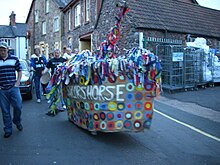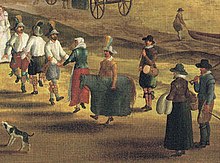This is an old revision of this page, as edited by Schmei (talk | contribs) at 19:23, 10 December 2010 (bar). The present address (URL) is a permanent link to this revision, which may differ significantly from the current revision.
Revision as of 19:23, 10 December 2010 by Schmei (talk | contribs) (bar)(diff) ← Previous revision | Latest revision (diff) | Newer revision → (diff)
A hobby horse (or hobby-horse) is a child's toy horse, particularly popular during the days before cars. Children played at riding a wooden hobby-horse made of a straight stick with a small horse's head (of wood or stuffed fabric), and perhaps reins, attached to one end. The bottom end of the stick sometimes had a small wheel or wheels attached. This toy was also sometimes known as a cock horse (as in the nursery rhyme Ride a cock horse to Banbury Cross).
A hobby horse is not always a riding-stick like the child's toy; larger hobby-horses feature in some traditional seasonal customs (such as Mummers Plays and the Morris dance in England), and they are constructed in several different ways.
Traditional seasonal customs in Britain
May Day hobby horses

The most famous traditional British hobby horses are probably those of the May Day 'Obby 'Oss festival in Padstow, Cornwall. They are made from a circular framework, tightly covered with shiny black material, carried on the shoulders of a dancer whose face is hidden by a grotesque mask attached to a tall, pointed hat. A skirt (made from the same material) hangs down from the edge of the frame to around knee-height. There is a small, wooden, horse's head with snapping jaws, attached to a long, straight neck, with a long mane, which sticks out from the front of the frame. On the opposite side there is a small tail of horsehair.
There are two rival horses and their fiercely loyal bands of supporters at Padstow: the 'Old 'Oss is decorated with white and red, and its supporters wear red scarves to show their allegiance; the Blue Ribbon 'Oss (or "Peace 'Oss") is decorated with white and blue and its supporters follow suit . A "Teaser" waving a padded club dances in front of each 'Oss, accompanied, as they dance through the narrow streets, by a lively band of melodeons, accordions and drums playing Padstow's traditional May Song. The 'Osses sometimes capture young women beneath the skirt of the hobby horse; often they emerge smeared with black.
Children sometimes make "Colt" 'Osses and hold their own May Day parades.

At Minehead in Somerset there are three rival hobby horses, the Original Sailor's Horse, Traditional Sailor's Horse and the Town Horse. They appear on May Eve (called "Show Night"), on May Day morning (when they salute the sunrise at a crossroads on the ouskirts of town), 2 May and 3 May (when a ceremony called "The Bootie" takes place in the evening at part of town called Cher) . Each horse is made of a boat-shaped wooden frame, pointed and built up at each end, which is carried on the dancer's shoulders. As at Padstow, his face is hidden by a mask attached to a tall, pointed hat. The top surface of the horse is covered with ribbons and strips of fabric. A long fabric skirt, painted with rows of multicoloured roundels, hangs down to the ground all round. A long tail is attached to the back of the frame. Each horse is accompanied by a small group of musicians and attendants. The Town Horse is accompanied by "Gullivers", dressed similarly to the horse but without the large frame; as at Padstow, smaller, children's horses have sometimes been constructed . The horses' visits are (or were) believed to bring good luck.
In the past there was also a similar hobby horse based at the nearby village of Dunster, which would sometimes visit Minehead .
The Hunting of the Earl of Rone
At Combe Martin in Devon a strange custom called "The Hunting of the Earl of Rone" took place on Ascension Day until 1837, when it was banned. It was revived in 1974 and now takes place over the four days of Spring Bank Holiday. A fool and a hobby horse, accompanied by grenadiers, search the village for the Earl, who is finally captured, mounted onto a (real) donkey and paraded through the village. He is frequently shot at by the soldiers, falls from his mount, and is revived by the hobby horse and the fool, and returned to his mount. Finally, on reaching the beach, the Earl is executed and thrown into the sea.
Morris and other ritual dance


A hobby horse is depicted in a stained glass window, dating from between 1550–1621, from Betley Hall, Staffordshire, now in the Victoria and Albert Museum, London, directly below a Maypole and surrounded by what appear to be morris dancers (accession no. C.248-1976) .
Some traditional English Morris dance sides (teams) have hobby horses associated with them. Some modern revival sides have extended their animal repertoire in various imaginative and appropriate ways, e.g. Pig Dyke Molly molly dancers, who wear black and white costumes and makeup, have a hobby zebra.
A hobby horse takes part in the ancient Abbots Bromley Horn Dance.
Other related seasonal customs in Britain
Soul-caking or Souling
Some regional variants of the Local seasonal variants, performed around All Souls' Day in Cheshire, included a non-speaking character called the "Wild Horse", made from a horse's skull mounted on a short pole. The horse was played by a man, hidden under a cloth attached to the pole, who bent forward to rest the pole on the ground. He could usually snap the horse's jaws loudly to frighten onlookers.
The Old Horse
In parts of Nottinghamshire, Derbyshire and around Sheffield there existed, into the early 20th century, a Christmas custom of going from house to house performing a short play or dramatised song called The Old Horse or T'Owd 'Oss. The horse was constructed in a similar way to the Wild Horse of the Soul-cakers and the hooden horses of Kent.
Hoodening
A custom which took place in the lead-up to Christmas in eastern Kent, involving a group of ploughmen leading a Hooden Horse (a horse's head made of wood, set on a short pole, with snapping jaws operated by a person hidden under a piece of sacking to represent the animal's body).
Mari Lwyd
A similar creature, the Mari Lwyd (Grey Mare in English), also made from a horse's skull, with a white sheet attached, took part in New Year house-visiting rituals in south-east Wales. The custom has been revived in recent years.
Penglas or Penglaz

The name of this creature from Cornwall translates as "grey head". It was a "hooden" or "mast" type of horse, either carved from wood or made from a horse's skull, like the Welsh Mari Lwyd, and accompanied the Christmas Guisers. Its body was a horse's hide or horse cloth. Sometimes it was led or ridden by Old Penglaze, a man with a blackened face who carried a staff. The animal has been revived in Penzance in recent years as Penglaz the Penzance 'Obby 'Oss and now appears on "Mazey Eve" and 23 June (St John's Eve) as part of a modern Midsummer festival, instead of around midwinter.
Origin of term
The word hobby is glossed by the OED as "a small or middle-sized horse; an ambling or pacing horse; a pony." The word is attested in English from the 14th century, as Middle English hobyn. Old French had hobin or haubby, whence Modern French aubin and Italian ubino. But the Old French term is apparently adopted from English rather than vice versa. OED connects it to "the by-name Hobin, Hobby", a variant of Robin" (compare the abbreviation Hob for Robert). This appears to have been a name customarily given to a cart-horse, as attested by White Kennett in his Parochial Antiquities (1695), who stated that "Our ploughmen to some one of their cart-horses generally give the name of Hobin, the very word which Phil. Comines uses, Hist. VI. vii." Another familiar form of the same Christian name, Dobbin has also become a generic name for a cart-horse.
Samuel Johnson, Dictionary of the English Language, 1755, glosses "A strong, active horse, of a middle size, said to have been originally from Ireland; an ambling nag."
Hoblers or Hovellers were men who kept a light nag that they may give instant information of threatened invasion. (Old French, hober, to move up and down; our hobby, q.v.) In mediæval times their duties were to reconnoitre, to carry intelligence, to harass stragglers, to act as spies, to intercept convoys, and to pursue fugitives. Henry Spelman (d. 1641) derived the word from "hobby".
- "Hobblers were another description of cavalry more lightly armed, and taken from the class of men rated at 15 pounds and upwards." - John Lingard: The History of England, (1819), vol. iv. chap. ii. p. 116.
The Border horses, called hobblers or hobbies, were small and active, and trained to cross the most difficult and boggy country, "and to get over where our footmen could scarce dare to follow." - George MacDonald Fraser, The Steel Bonnets, The Story of the Anglo-Scottish Border Reivers.
Other meanings

From "hobby horse" came the expression "to ride one's hobby-horse", meaning "to follow a favourite pastime", and in turn, the modern sense of the term hobby.
The term is also connected to the draisine, a forerunner of the bicycle, invented by Baron Karl von Drais. In 1818, a London coach-maker named Denis Johnson began producing an improved version, which was popularly known as the "hobby-horse".
The artistic movement, Dada, is possibly named after a French child's word for hobby-horse.
References
- "hobby," The Oxford English Dictionary. 2nd ed. 1989. OED Online. Oxford University Press. Retrieved 2010-06-26.
- David V. Herlihy, Bicycle, Yale University Press, 2004; pp. 31-38.
- Marc Dachy, Dada & les dadaïsmes, Paris, Gallimard, "Folio Essais", n° 257, 1994.
See also
- Hooden horse - an unrelated but similar custom in Kent
- Dorset Ooser